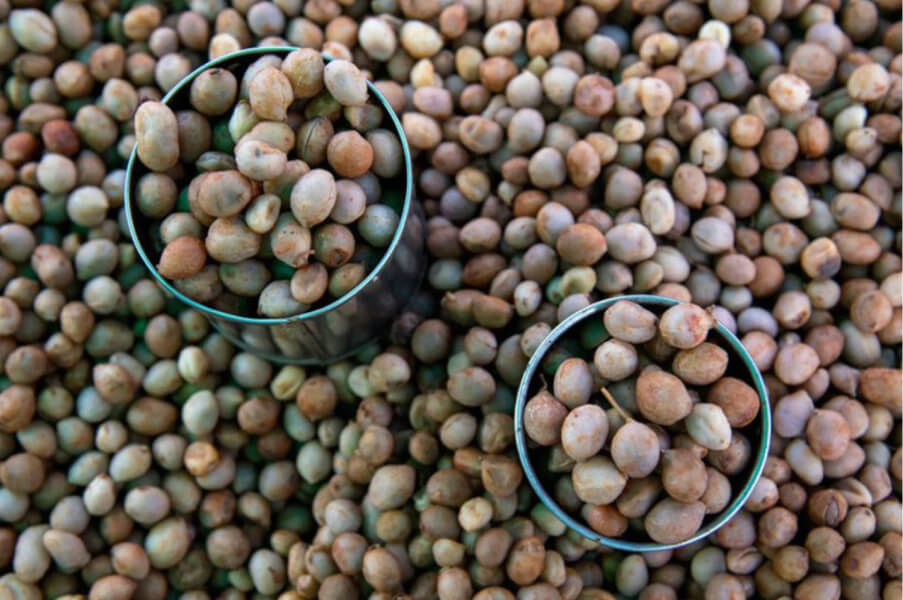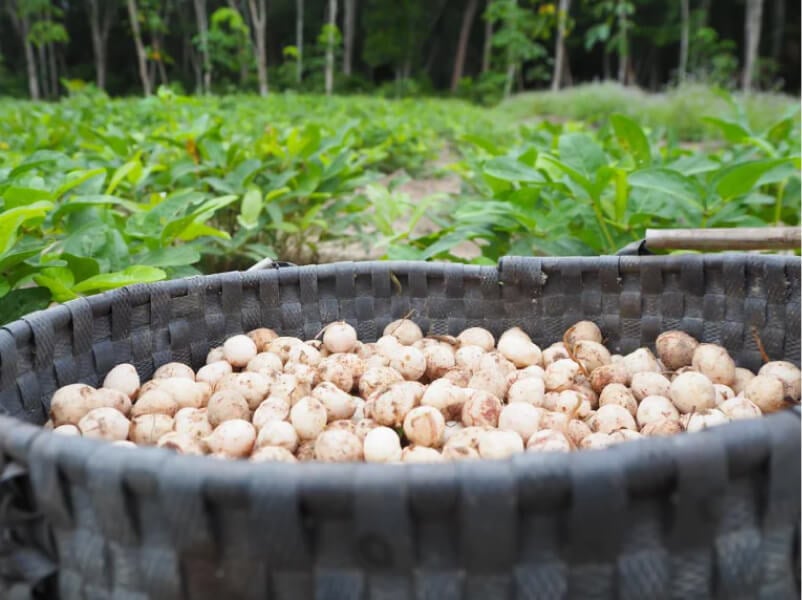
Bambara groundnut takes the center stage at WhatIF Foods as the key regenerative ingredient for all our high-protein noodles and milks. But the real question is what is Bambara groundnut and why do we love it so much?
Where are Bambara groundnuts from?
Bambara groundnut, also known scientifically as Vigna subterranean, or BAMnut for short, is a wonderful legume native to West Africa and is grown at a low level extensively throughout sub-Saharan Africa. The crop is also grown in Southeast Asia, across regions in Thailand and Indonesia. It is a hardy legume with the ability to grow in poor soil conditions and arid climate, without needing fertilizers, or pesticides. [1]
These unique traits make the Bambara groundnut the go-to crop for financially constrained farming communities as it’s able to provide them with a definite harvest and food source.[1] Traditionally, the BAMnut has been consumed in various forms: eaten whole as snacks (cooked by boiling, roasting, frying); mixed into porridges and breads as flour.
Fun fact: Bambara groundnut got its name from the Bambara ethnic group, residing in modern Mali, Guinea, Burkina Faso, and Senegal!
Why Do We Love the BAMnut Here at WhatIF Foods?
Glad you asked. The BAMnut is what we like to call a regenerative crop due to its awesome nutritional profile, climate-resiliency, and ability to grow in degraded lands with minimal demands for input of resources. They even rejuvenate said lands through its nitrogen-fixing roots. I mean… come on! Who wouldn’t love a crop that not only replenishes you nutritiously, but also restores the lands it’s grown in?
Tell Me More About this 'Awesome' Nutritional Profile...
The BamNut is so nutritionally dense that it’s been referred to by farming communities as a 'complete food' as they supposedly can live on the legume alone. [2][3] On average, 20% of the calories from the Bambara groundnut are from protein, making it a good daily source of protein.[4] It also possess all the essential amino acids, and two types of essential fatty acids. [4][5] In terms of micro- nutrients, it’s a good source of up to seven minerals, and a few B-vitamins[5].
What About the Regenerative Ability of the Bambara Groundnut as a Food Source?
These are exactly the questions we need you to ask as we join hands to challenge the status-quo of our ‘broken’ food system. There are three main ways the Bambara groundnut is a regenerative food source.
1. Low Environmental Footprint
The Bambara groundnut is a good source of protein with a low environmental footprint. For instance, one gram of protein from pulses like Bambara groundnut only require 1/10th of the water footprint that would be required to obtain one gram of protein from bovines[7].
2. Resilient Food Source
The Bambara groundnut is a secure and resilient food source. Bambara groundnuts can survive and thrive in tough conditions with minimal demand for resources and inputs[4], making it the ideal crop to add to our food basket as we brace ourselves for the accelerating effects of climate change and population growth, such as prolonged drought, reduction in arable land, increased areas of degraded soil unsuitable for farming, and other environmental disasters.
3. Remediation of Degraded Lands
Most impressively, we might add, Bambara groundnut can help remediate and reclaim degraded lands. As a legume, Bambara groundnut has the ability to capture atmospheric nitrogen and convert it into nitrogen compounds in the soil. The Bambara groundnut improves the overall soil fertility where it is grown. A small-scale trial in Ghana[8], where the legume was grown in soil degraded by intensive mining activity, has shown that Bambara groundnut can remediate the acidic soil by the aluminum and hydrogen content of the soil. The soil's biodiversity and nutrients, including nitrogen, phosphorus, calcium and magnesium, also significantly increased.
Pretty Impressive for an 'Underutilized' Crop, Right?
WhatIF Foods strives to harness the raw potential of Bambara groundnut. We believe that to change our current food system, we need to harness the resilience and nutrition of these powerful plants nature has given us. Our team of food scientists have successfully incorporated Bambara groundnuts in a variety of products that are familiar and accessible to consumers like instant noodles and, most recently, milk, that you see on our product pages.
We'd love to hear what you think! Let us know at hello@whatif-foods.com and perhaps grab a Bambara groundnut item on the way?
What's next?
Read all about the mighty BAMnut and its journey to your kitchen here.
Learn more about the show-stopping nutritional profile of BAMnut here.
Discover how biochar plays an important role in reducing our carbon footprint here.
Find out how we create a Better Better with our partner farming communities here.
References:
[1] J. Mubaiwa, V. Fogliano, C. Chidewe, and E. J. Bakker, “Utilization of bambara groundnut ( Vigna subterranea ( L .) Verdc .) for sustainable food and nutrition security in semi-arid regions of Zimbabwe,” PLOS One, pp. 1–19, 2018.
[2] C. T. Nono, W. F. Gouertoumbo, and E. Youmbi, “Origin and Ecology of Bambara Groundnut ( Vigna Subterranea ( L .) Verdc : A Review,” no. November, 2018.
[3] R. J. Hillocks, C. Bennett, O. M. Mponda, and C. Maritime, “Bambara nut : a review of utilisation , market potential and crop improvement,” African Crop Sci. J., vol. 20, no. 1, pp. 1–16, 2012.
[4] R. Azman Halimi, B. J. Barkla, S. Mayes, and G. J. King, “The potential of the underutilized pulse bambara groundnut (Vigna subterranea (L.) Verdc.) for nutritional food security,” J. Food Compos. Anal., vol. 77, pp. 47–59, 2019.
[5] D. N. D. Yao, K. N. Kouassi, D. Erba, F. Scazzina, N. Pellegrini, and M. C. Casiraghi, “Nutritive Evaluation of the Bambara Groundnut Ci12 Landrace [ Vigna subterranea ( L .) Verdc . ( Fabaceae )] Produced in Côte d ’ Ivoire,” Int. J. Mol. Sci., vol. 16, pp. 21428–21441, 2015.
[6] J. Mubaiwa, V. Fogliano, C. Chidewe, and A. R. Linnemann, “Bambara groundnut ( Vigna subterranea ( L .) Verdc .) flour : A functional ingredient to favour the use of an unexploited sustainable protein source,” pp. 1–19, 2018.
[7] Water Footprint Network, “Water footprint of crop and animal products: a comparison,” PLOS One, 2014. [8] C. Daniel, O. D. Wiafe, and B. O. Boye, "Restoration of biodiversity using voandzeia subterranea (Bambara beans) ,’” 2016.



